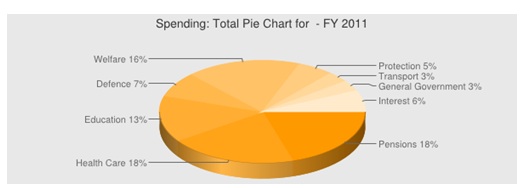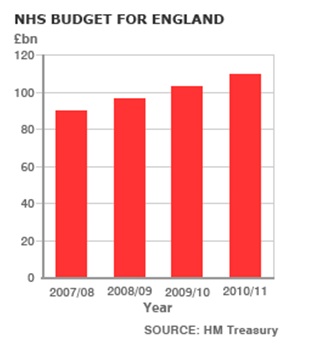Every organization requires some amount of initial finance to start its business. The potential long term sources of finance that are available to any organisation are equity and debt. Equity includes either ordinary shares or preference shares. Ordinary shares are issued by an organization and are publicly traded on the stock exchanges. However, preference shares give the shareholders a right to convert into equity ordinary shares and also, receive a return at a particular rate. However, debt includes loan from banks or any other financial institution and loan from relatives. This form of funding brings with it huge interest payments burden. The other sources of funding that can be used are Government sources, retained earnings and leasing. (Anon., 2004)
National Health Service (NHS) is an organization that was established on 5th July 1948 with a view to provide a comprehensive range of services related to health only. These services are given to all the UK citizens. It is the largest publicly funded health service in the world. The organization works on the principle that good health services should be available to all the citizens of the nation regardless of wealth. (bartsandthelondonnhs, 2011)
The basic sources of funding for the NHS are derived from the general taxation and fee at the point of use. There are grants that are made available to the NHS for its administrative purposes. Each country is free to decide how much to allocate towards NHS. NHS also procures its income from the patient charges which include prescription charges and dental charges. Other sources of funding available to NHS are through car parking charges, patient telephone services, etc. (bartsandthelondonnhs, 2011)
The expenditure in the NHS is decided by the need based system. From the commencement of NHS, the expenditure has increased to almost 100%. The expenditure on various health services has been increasinged significantly in the recent years especially more with the total expenditure on the health services as a proportion of Gross Domestic Product. Thise expenditure on these services has increased sharply from 5.6% in the year 1980 to 8.7% in the year 2008. Not only this, Tthe spending expenditure on health services has increased rapidly between 1997 (6.6% of GDP) and 2008 (8.7% of GDP). Out of this, the proportion of expenditure that came from public funds varied from 89% in 1980 to 79% in 2000, and back to 83% in 2008. (Anon., 2004)
Since the launch of the NHS in 1948, it NHS always had a budget of approximately £437 million which corresponds to nine billion pounds presently. (roughly £9 billion at today’s value). However, the NHS budget has now increased for the year coming 2011-12 to approximately £106 billion.

The pie chart shows the spending or the budget made available to the health sector in the United Kingdom for the fiscal year 2011. The proportion of the total spending that is allocated to the health services is as high as 18 percent. (Anon., 2008/09)
On 10th October, 2007, the National Health Service was about to receive an increasedment in the budget from £90 billion pounds that year to £approximatel 110 billion pounds by the year 2010-11, almost an approximate increase of 4% percent. This was actually announced by the Chancellor that year. The purpose of the additional investment was to help the health services realize the savings of around approximately £8.2 billion pounds by the year 2010–11. This was to be achieved with the help of the new technology. An investment of £100m innovation fund was to be introduced created by the Department of Health. This was majorly to help the National Health Service develop the high- technology healthcare devices such as medical devices and other medical diagnostics. This would have helped the NHS achieve its mission of fair, personalized, effective and safe services. The fund that will be invested in the NHS was to be controlled by a new Health Innovation Council. The new Health Innovation council was being headed chaired by the health minister of health, Lord Darzi. This enabled the NHS to deliver the results for the patients that are among the best in the world – saving more lives and improving the quality of life. The NHS was able to reduce the unnecessary variations in the productivity across its services with the help of the new technologies and the best practices. As a result of which, the NHS could be able to generate release the cash-releasing savings of approximate £500 million pounds per year by 2010-11. However, considering the longer horizon, the increasing rate of the life expectancy and the changing lifestyle could pose lead to some additional challenges problems to the budget of the NHS. More technological innovations will be required to further improve the quality of life of people by a greater amount. Ths NHS has successfully improved the quality of its services by improving GP access to its patients through its budget. There is a £250 million of investment made for some hender and fifty 150 new walk in health centres that are will be open seven days a week and around 100 new GP practices in the areas where there is lack of services. NHS budget is committed towards providing better support to people with long-term illnesses. It helps these people to live independently and have a control of their own condition.The growth in the Department of Health’s social care funding will support the new policy initiatives and it will help in increasing the funding by £190 million. This investmentfunding will always help the local authorities to build on the make progress made in developing the personalised services. These services will give the people citizens and their careers a greater choice and a control over the way in which their needs have to be met.
The increase in the NHS spending in the year 2007 came during the first pre-budget report that stated the economic growth to be growing at a rate of 2 to 2.5% next year due to the international economic uncertainty.
However, the year of 2011 has something else in stored in it. The health services faced an extremely challenging financial uncertainty. Though, the NHS funding did increased or rather tripled since 1997 on account of strong financial footing, yet this year the budget could experience a downfall. This is mainly on account of increase in the rising costs and the ageing population year after year in the field of healthcare services. As a result, NHS in UK will face a reduction of around £8bn - 10bn over the three years after the year of 2011. The budget experienced a cut in the staff numbers and a cap was also put on the budget for the new drugs. The health services are experiencing a great mismatch in the income tax and the expenditure budgets. There was a cap put on the amount that was available to the NHS in the year 2011.

The NHS has to be well-placed to deal with the tough economic times that are lying ahead. The NHS has to keep its focus on the prevention, the quality and the innovation.
In order to do so, the NHS has to improve the quality of the healthcare services in the country by using the current resources. After years of significant expansion, it will be difficult for the NHS to be able to simply grow to meet demand amidst raising difficult situations ahead.
Although, it is very difficult to measure the efficiency of the healthcare services offered yet the NHS efficiency needs to be measured as a huge amount of the budget is allocated to them. However, there are some key performance indicators that are set for the NHS in their budgets. The key performance indicators are the operational budget position, the return on the net assets, the cash in the bank and the income and expenditure net surplus. All these indicators are reviewed annually. The operating income for the year 2011-12 that was planned was £ 89.5 million but the actual turned out to be £ 90.6 million, the variance of £ 1.1 million. Also, the operating expense that was planned for the year 2011-12 was £ 89.7 million but the actual turned out to be £ 93.1 million. The variance in expenditure was around £ 3.4 million. The main sources of income for the NHS are clinical income from the NHS, clinical income from the private patients, income from research and development and the income from the education and training. The major areas of expenditure of the funds in the NHS include the pay costs, the drug costs and the clinical services that are provided to the public. If one look at the net surplus for the fiscal year 2011-12, there is a huge amount of variance in it too. The planned net surplus for the year was £ 0.7 million and the forecasted turned out to be (£ 1.9 million). The variance was also in red and stood at £ 2.6 million. Some of the indicators are shown in the figure below:

Based on the above indicators, the NHS has not shown any variances in the budget planning whether it is EBITDA or it is net margin. (Chantrill, 2011)
If there is a need, the expenditure on NHS can be increased as it has been in the past. The alternative model for evaluating expenditure is “Cost based expenditure”. It has various limitations. Health sector is an integral part for any nation. The requirement of the health services cannot be fulfilled by looking at the costs. Thus, need for the health sector is important and not cost that matters. (Chantrill, 2011)
Project management includes the proper utilisation of the resources in an efficient as well as an effective way. NHS is an important health service provider. Project management plays an important role in the health sector. Thus, project management plays a vital role in the National Health Security. (Chantrill, 2011)
The expenditure includes drug costs and pay costs. Thus, there is an increment required in the expenditure plan of the NHS over the years to give proper service to the public. With the number of the diseases increasing over the years, the expenditure on the drug costs has to increase exponentially. On the similar lines, the pay cost has to increase too. This means a greater budget has to be allocated towards the NHS. However, the budget has seen an increase in the public finances. From the year 1949 to 1997, the NHS spending has been growing at an average of 3.5 percent a year in the real terms. (bartsandthelondonnhs, 2011)
Responsibilities will increase manifold as the number of the patients will increase in the coming years. The responsibilities are increasing but the NHS has been showing a vast reduction in the waiting times. There are thousands of more doctors and nurses. Almost dozens of new hospitals have sprung up and will do so in the coming years. The death rates from cancer and the heart disease has fallen sharply. NHS has been showing signs of increment. (Anon., 2004)
Timescale to achieve such magnificent milestones is very crucial. The NHS has to deliver everything in fewer time frames. Thus, the project planning needs to take of this. This is because with the increase in the services of the NHS, the expectations will increase too.
Once the project is into effect, the post monitoring is an essential element. The planned project criteria and the actual ones have to be evaluated and the variances have to be catered to. The comparison of the activity performance against the contract plan is essential. The project can impose the contract performance targets and the nationally defined penalties.
The project also needs to take into care that the benefits accrue to the public as they are the receivers of the service. (Anon., 2012)